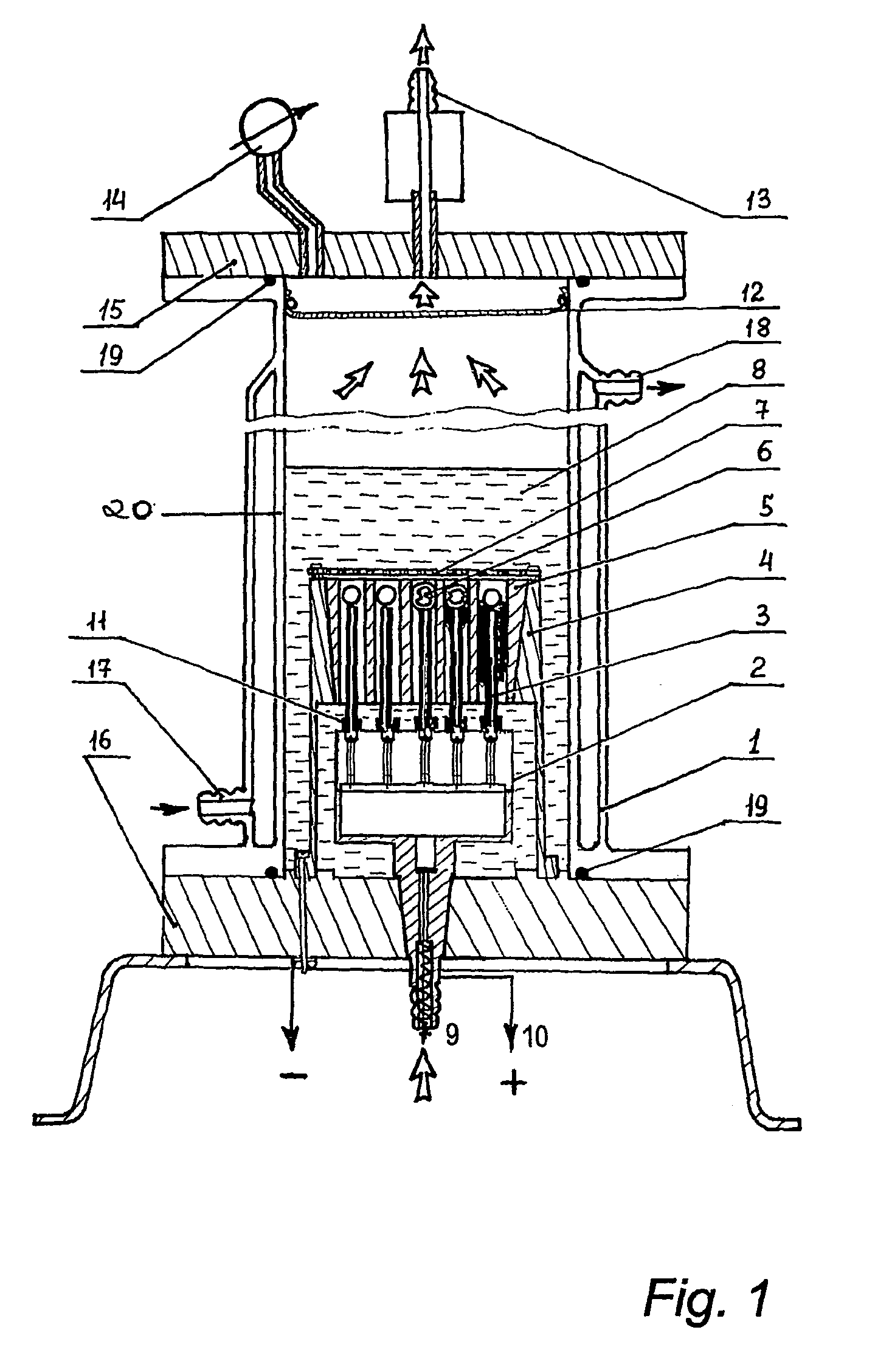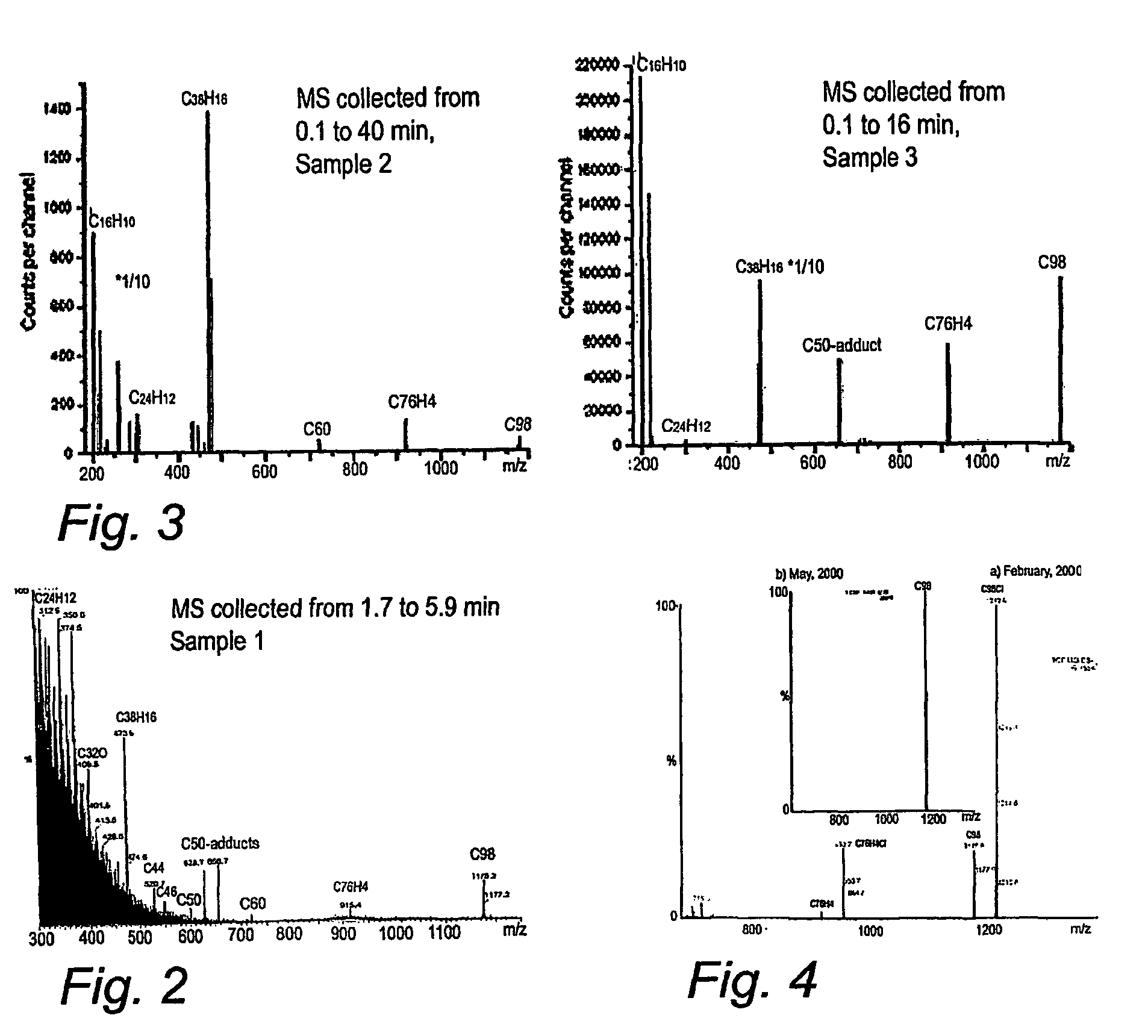Apparatus and method for nanoparticle and nanotube production and use therefor for gas storage
a technology of apparatus and nanotubes, which is applied in the direction of mechanical apparatus, energy-based chemical/physical/physicochemical processes, and fullerenes. it can solve the problems of low yield of lower and higher fullerenes, affecting the production of nanotubes on a commercial scale, and affecting the production of nanotubes. it achieves the effect of avoiding saturation of the arc gap and increasing yield
- Summary
- Abstract
- Description
- Claims
- Application Information
AI Technical Summary
Benefits of technology
Problems solved by technology
Method used
Image
Examples
example 2
Producing Nanotube / Nanoparticle Deposits with an AC Power Supply Using the Apparatus of FIG. 1.
[0190] Apparatus 1 can be used (FIG. 1) to produce nanotube deposits over the electrodes 3,5.
[0191] The body is filled by an aromatic liquid 8, like benzene, toluene, xylenes, Co- and Ni-naphtenates based on toluene etc., or their mixtures to a level that is, at least, enough to cover the contactors 6.
[0192] Before the reaction commences, air is pumped out from the body through the outlet of a safety valve 13 and pure argon gas is pumped through the inlet 9 and through the pipes 3 (electrode A) to fill the empty space to a pressure that is optimal for producing carbon nanotubes / nanoparticles, most preferably, in the range of 600-800 Torr. Afterwards, an argon flow through the opening is maintained in the range of 1-3 liter per hour per a pair of electrodes, i.e. about 20-60 liters per hour for this apparatus.
[0193] As soon as the power supply 10 is switched on the process starts. With a no...
example 3
Producing Nanotube / Nanoparticle Deposits with a DC Power Supply Using the Apparatus of FIG. 1.
[0203] DC power supplies appear to be more preferable for producing nanotube / buckyonion deposits. FIG. 6 shows an experimental dependence of the deposits compositions and their yields versus a DC voltage applied. From this dependence one can see that in this apparatus producing nanotube / nanoparticle deposits starts at voltage of about 20 V.
[0204] The most preferable voltage for producing MWNTs is within the range from 24 to 30V with the deposits' yields of 0.4-1.0 g / min, correspondingly. Increasing applied voltages over 36V are likely to increase yields of buckyonions, graphite and metal clusters.
[0205] Increasing the applied voltage over 28-30 Volts requires putting one or two additional contactors above the usual one to maintain optimal arcing (these additional contactors are not eroded at all and may be used many times).
[0206] There are two different kinds of deposits, "hard" shells and ...
example 4
Producing Nanotube / Nanoparticle Deposits Using the Apparatus of FIG. 13
[0226] The apparatus for producing fullerenes illustrated in FIG. 13 includes a hermetically sealed chamber 21, in which a holder 22 of the electrodes A 23 and a holder 24 of the electrode B 25, and fixed spherical or hemisherical graphite contactors 26 are situated below the electrodes A 23 above a metallic grid 27. This arrangement is immersed in a hydrocarbon liquid 28 and is connected to a valve 29 (for adding a buffer gas into the chamber 1 around the electrodes), and to a standard AC power supply 30 typically used for welding (three phase voltage, 53V, 50 Hz).
[0227] Cylindrical rods 23 (electrodes A) with a smaller diameter are installed in holder 22 by using cylindrical ceramic insulators 31 and are connected to the holder using safety wires. The rods 23 are axially installed inside a vertical cylindrical opening of a graphite matrix 25 (electrode B).
[0228] FIG. 13 shows a design of the apparatus with 19 p...
PUM
 Login to View More
Login to View More Abstract
Description
Claims
Application Information
 Login to View More
Login to View More - R&D
- Intellectual Property
- Life Sciences
- Materials
- Tech Scout
- Unparalleled Data Quality
- Higher Quality Content
- 60% Fewer Hallucinations
Browse by: Latest US Patents, China's latest patents, Technical Efficacy Thesaurus, Application Domain, Technology Topic, Popular Technical Reports.
© 2025 PatSnap. All rights reserved.Legal|Privacy policy|Modern Slavery Act Transparency Statement|Sitemap|About US| Contact US: help@patsnap.com



